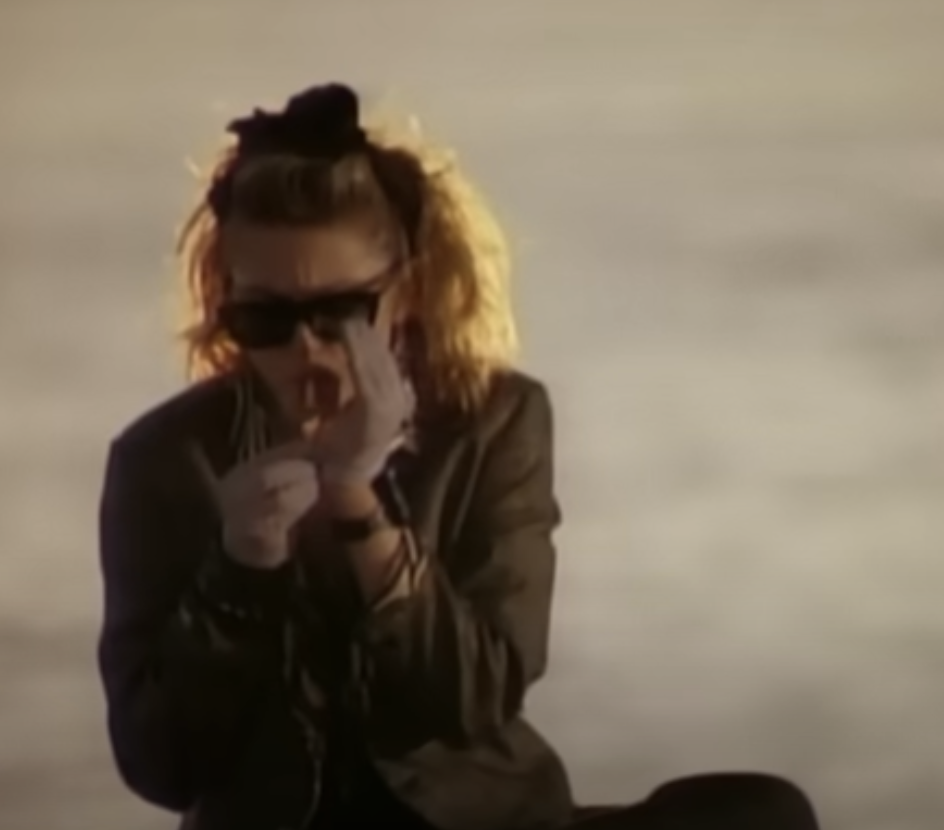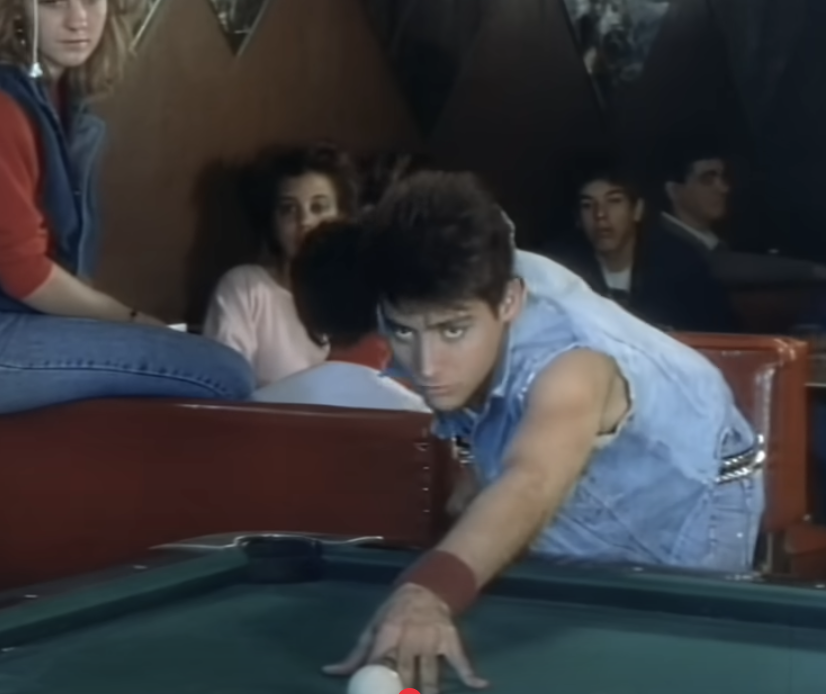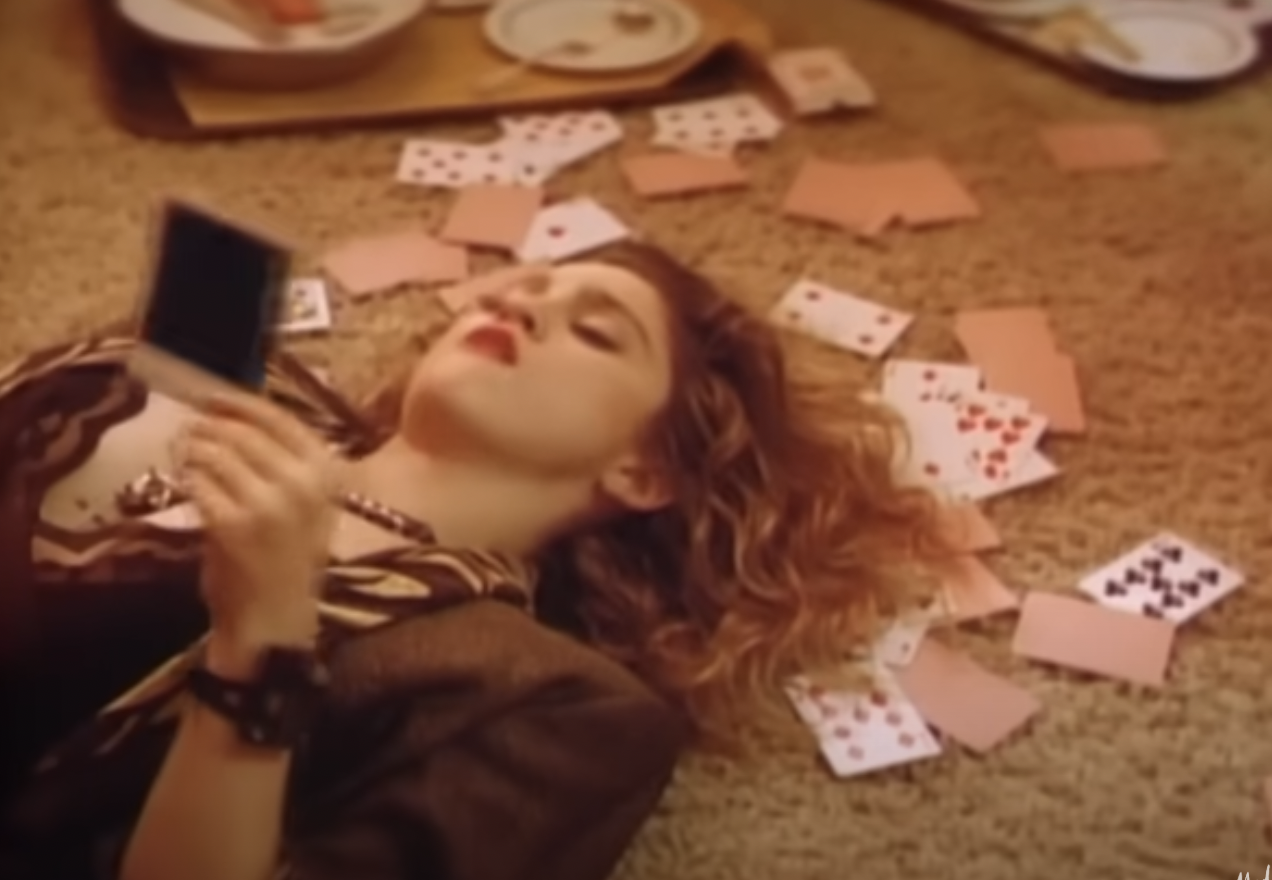“…as happened for me with Vinteuil’s sonata—it’s the least remarkable parts we notice first. […] Less disappointing than life, great works of art do not start out by giving us the best they have.”
— Marcel Proust, In the Shadow of Girls in Blossom (tr. Charlotte Mandell)
for Jael, who asked me a question about music, poetry, and eros that I could not answer without sprawling a bit
THE “BEST OF ME” . . .
At the beginning of “Borderline,” Madonna is hanging out, loitering on the street with some guys while the instrumental intro shapes the beat. Then, randomly, she begins dancing with one of them. From 0:14 to 0:20, we watch this awkward dance. Everything that follows begins in that four-second flirtation with the possibility of tandem motion.
To break down those four seconds: the He and the She move around each other, almost as if they are sniffing each other out, introducing their rhythms … And yes, it is cheesy. It is tacky as hell, both visually and figuratively, this depiction of two strangers trying to match each other’s movements, to meet in that motion.
Despite the short duration, something could begin in this asynchronous encounter, and the could appears in this fragmentation and distance. The movements of an Other that provides the frame for what is to come.
The vocals begin by articulating a problem: Something in the way you love me won't let me be. The first word, “something,” suggests that part of the problem is finding words for the thing. The limits of language are given to us at the outset. And then there is also that side-by-side rhyme of “me” and “be,” a positioning that calls to mind the abandoned dance steps. I find my ear drawn to the simplicity of the pronouns, where an intonation that stresses the me, the you, and the be draw closer to the imagining of a we.
I don't want to be your prisoner
So baby, won't you set me free?
Notice how the statement closes in another the monosyllabic, side-by-side rhyme with “set me free” (as with earlier “let me be”)? I think the rhyme works against the implications of being freed by love, because, of course, the prison is the desire itself. The prison is the prism of possibility, which is why the next two lines work magic:
Stop playing with my heart
Finish what you start
Heart/start: an end-rhyme. The side-by-side rhymes abandoned for the material. And one can already sense the disaster, where to “stop playing” is to abandon the game, and to “finish,” here, would indicate an end to exactly what Madonna (or the speaker) is pursuing. The whole song is filled with lyrics that play on the game itself, asking for an end to the game while begging the game to continue:
Baby, let it show
Honey, don't you fool around
Who is the “fool” in this fooling-around? How to evade the circle evoked by this word, “around,” in the idiomatic context where fooling-around also insinuates itself back into that opening dance and its gyrations?
The fool “hooks up with” the foolishness of those four seconds, in figuration.
Madonna is building on the romantic trope that stages desire as a crossing of class and social boundaries. This, too, is at play in the song. And the video depicts it by alternating back and forth between scenes with the wealthy, glamorous photographer (in black and white) and the street-dancing guy (in color). Elegance vs. messiness. Artifice vs. authenticity. Status vs. friskiness. Of course none of these dichotomies are stable, and part of the fun lies in comparing the varying sort of artifice in the performance of street-guy and fancy-man.
Performing one’s self vs. being one’s self: another romantic opposition that is (too) easily resolved in the juxtaposition of images. While her relationship with the photographer takes place within rooms, where the pleasure involves making an art of the bounded space.
The reasonable speaker intervenes:
Just try to understand
I’ve given all I can
'Cause you got the best of me.
That third is brilliant in its multiple readings. “You got the best of me,” as in, you won, you beat me at the game, and maybe one only realizes the game is being played when faced with having lost it. Maybe that’s part of this strange synergy.
“You got the best of me,” as in, I gave you the best part of myself, or you managed to get it somehow, and so this dance is one that feels like a losing of one’s best self, a shadow or a possibility.
“You got the best of me,” as in, now I am forced to reconcile the boundaries of my selfhood, that line “of me” which wants to be dissolved in the “You.” But—
Something in your eyes is making such a fool of me.
Clearly her sense of me is at risk in this encounter where the gaze of the other becomes a mirror. And so, to continue with this stanza:
When you hold me in your arms
You love me 'til I just can't see
— and seeing allows me to be rather be defined by the act of seeing the “self” in that bounded pronoun, me. That is the erotic pact: to be simultaneously present and absent, freed from subjectivity and convention, a freedom that becomes its own chain.
In the stills above, fancy-man puts a hat on her; she rips it off and rejects it. Then she goes to look for street-guy and tries to get his attention. He rejects her for a different game, namely, pool. When she stands in the doorway as he lines up a shot, he looks up at her and then back at the pool table.
Nevertheless, all of this begins with (and returns to) those brief gyrations at the beginning, in that encounter with strangeness that elicits interest. Everything revolves around the glitches and barriers. Ecstasy unbounds us. This is how eros moves, on the page, in the room, on the street corner, in the meadow, anywhere humans wander or breath.
“Borderline” ends with that pressure against the “me,” in that repetition — Keep pushing me, Keep pushing me, Keep pushing my love. And then, because Madonna wants to show she can play the game, she ends with that C’mon baby.
TO “GET INTO” . . .
Madonna also mobilizes this relationship between rhythm, embodiment, and ecstasy in “Get Into the Groove.”
The structure is similar. Ignoring the plot of the film and focusing on the images in the video, the romantic dichotomy of wild boy vs. groomed boy, with all the usual connotations, appears. As in “Borderline,” it’s her move: she dares the man to meet her in the might be, in that unknown possibility.
If we read the video without drawing on the plot of Desperately Seeking Susan, then we have a series of images, of stills, if you will:
The playing cards indicate that the speaker knows she is playing a game, and it may be a new game, or a variation on an old game. The photo in her hand brings an Other to the table, something particular to this game and its performance. “Desperately Seeking Susan": an ad which she takes as an opportunity. Perhaps she’s trying to meet a different possible self in the act of imitation—which we do in poetry, when we write poems “after” a writer or a different poem that moved us. Although Madonna’s persona is clearly trying to game a pre-existing situation, the fact of the con doesn’t prevent the con from escaping her plans.
Dance, or dancing, feels like a labyrinth in this song. I could over-read it for hours.
Scenes are ruptured by flashes that return us to the dance floor, repeatedly, as if something is being resolved or worked out in that mass of bodies beneath the red lights. There are glances, rejections, rapprochements, dalliances, a constant sense of flux, a grinding sculpture of silhouettes that cannot settle definitively.
And you can dance (beat) For inspiration (breath) Come on (beat) I’m waiting (breath).
So, there is movement within and between sound, as guarded by the beat, or embodied by breath, but there is also a structure of repetition central to the pop song itself. Since several verses are repeated, I won’t talk about a refrain but focus on the pattern of repetitions, which is as follows:
Intro, as quoted in the four phrases above, followed by 12 verses arranged in the following pattern:
A / B / C / D / C / A / E / A / C / E / E variation / A
This command to get in the groove, which occurs in Verse A, names dance as the means of “getting to” a relational knowledge or experience. And there is the gauntlet, scaffolded as an invitation to meet her in the beat:
Step to the beat
Boy what will it be
She enjoins him to “step to” it; to risk entering the music:
Music can be such a revelation
Dancing around you feel the sweet sensation
Notice that word “around” again? Round and round we go, trying to find the ‘groove.” Lyric-wise, we’ve moved from “inspiration” to “revelation,” but what these terms share is a religious or spiritual association. Both words refer to acts that ordinarily relegated to religious epiphany, or the ecstasy of the saints. Using this sacred language immediately introduces the possibility of profanation.
Step to it, see what happens: a rhyming word hovers in the background. Call it “temptation”:
We might be lovers if the rhythm’s right
I hope this feeling never ends tonight
The end-rhymes continue building momentum forward, creating musicality, linking sound to sound in those long vowels.
The refrain turns again to the particular knowledge mentioned at the beginning of the song, that “getting to” know (Gonna get to know you in a special way) that is unique, set apart from the ordinary (This doesn't happen to me every day), as the end-rhymes propel us forward, creating order within the saying—-
Don't try to hide it love wears no disguise
I see the fire burning in your eyes
— but end-rhymes also provide a space for slippage, where words lose meaning and become closer to sheer sound. And humans respond to both: the meaning and the sound. Our ears and our minds process these stimuli at the same time.
While screenshotting, I noticed the slightly Lynchian flavor that lingers on the cusp of materiality, in that space between fade-ins and fade-outs, when things are shifting from one frame to another. Maybe there is a way in which this very slippage, this motion between, maps onto Madonna’s character, who shifts between roles and selves as smoothly as she does hair colors.
In these multiple dances with an Other, it is her own strangeness that is being courted or played upon. Here, recognition occurs in the dance, or the matching of the beat: what she recognizes in the Other is a possible self, a dance, a trick, a con, an opportunity. But there is another kind of recognition that meanders through this video, and I turn to it now.
TO “MOVE IN TIME” . . .
It is true that skipped over the recognitions of the self-similar in this video. And I’d like to try and think about this type of recognition without abandoning the music where the lyrics left off. Maybe both can be laid side by side? Hell, it’s worth a try.
Leaving the movie plot aside, looking only the images in the video, there is a fellow who returns without introduction. Madonna’s character is always delighted to see him: she abandons her roles and performances in his presence. This fellow is the man who meets her where she is, so to speak, in her aloneness. Our knowledge of him is limited to the relief (or maybe happiness) on her face when she sees him.
In my evasions of the self-similar counterpart, I also neglected to mention Verse E, which occurs twice, and also happens to be the only verse that gets repeated in a variation.
One might even venture to say that the unmentioned Verse E sits at the edge of the song’s dissolution, which is preceded by the turn of that headlong repetition loosely named as an “E variation.”
I give you Verse E:
Live out your fantasy here with me
Just let the music set you free
Touch my body, and move in time
Now I know you're mine
The stakes are explicit, despite their uncertainty: live in the now, in this here, with me, in this fantasy where the music gives us a moment to imagine each other. Touch my body—- and move in time — where time is both the motion in tandem as well as the temporality of Now. Here. This. A mutual recognition accompanied by knowledge: you are mine for the duration, where “mine” could mean anything. Or nothing.
Yet there is a difference in this type of recognition between strangers, a recognition that lacks the temporality claimed by self-similar recognitions. The repetition is that of the game, itself, not the actual selves implicated in desiring each other.
I don’t know if that means the games are different, or self-similar eros occurs without the scaffolding of a game. Games have rules, after all, and we play them to learn the rules or test ourselves within them.
But what do we know about love and eros? Recognition, rhythm, repetition: a recipe.
I leave you with the “E variation,” that shimmering texture of repetition that alters the valence of what is repeated*:
Now I know you're mine,
now I know you're mine
Now I know you're mine,
now I know you're mine
* Whether in sonnet form or in scenario, variations, by nature, are endless.





















